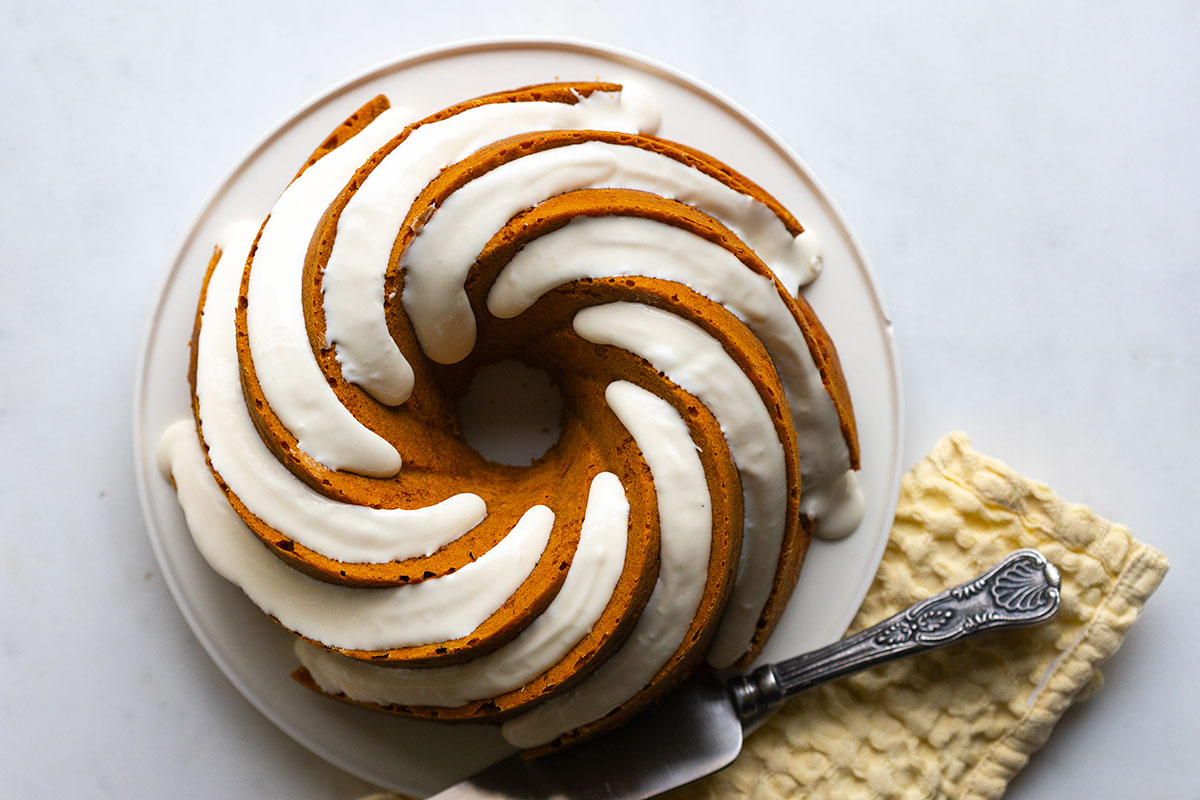Ingredients and Directions
- Cake
Directions
Place ½ cup (1 stick) of butter in a small saucepan over medium heat. Allow the butter to melt completely. Just before it starts to brown, it will begin to foam up. Slowly whisk or swirl the butter until it begins to turn a warm chestnut color and tiny brown flecks start to form on the bottom of the pan. This is a delicate process, so stay vigilant. You want the butter browned, but not burnt. Once you’ve browned the butter, pour it into a heatproof bowl and allow to cool completely.
Place oven rack in the bottom 3rd of the oven and preheat the oven to 350° F.
Prepare a 10 cup bundt pan by brushing the inside (into all of the nooks and crannies) with 1 tablespoon of softened butter with a pastry brush, then lightly dust the buttered pan with an even layer of granulated sugar. Tap the pan on all sides to ensure the sugar sticks and coats the entire pan.
Sift together the cake flour, pumpkin pie spice, salt, baking powder and baking soda in a bowl, then whisk by hand to ensure that the ingredients are well mixed.
In the bowl of a stand mixer fitted with the paddle attachment, cream the remaining butter, cooled brown butter and sugars together on medium-high speed until fluffy, about 3-5 minutes, stopping to frequently scrape the paddle and the sides of the bowl with a spatula. With the mixer on a low speed, blend in the eggs one at a time, followed by the vanilla
Combine the pumpkin, buttermilk and maple syrup in a bowl, stir to blend together. With the mixer on low speed, add the flour mixture in three parts, alternating with the pumpkin mixture in two parts, beginning and ending with the flour. After each addition, mix until just barely blended and stop and scrape down the bowl. Stop the mixture before the last flour addition and blend by hand with a spatula until the mix is just combined.
Pour the batter into the prepared bundt pan and spread it out evenly. Gently tap the pan on the counter a few times to release any air bubbles. Place the bundt pan on a baking sheet in the oven. Bake until the cake is golden and springs back; until a wooden skewer inserted in the center comes out clean. About 55-60 minutes
Allow the cake to cool in the bundt pan for 15 minutes. Then gently invert the cake and plop it out onto a wire rack or serving plate. You may need to use oven mitts if the pan is still hot to the touch. Allow to cool completely before preparing the cream cheese icing.
Ingredients
- 1 cup unsalted butter at room temperature - divided
- 3 cups pastry or cake flour
- 1 tbsp. pumpkin pie spice
- 1 tsp. fine sea salt
- 1 tsp. baking soda
- 1/2 tsp. baking powder
- cup + 1 tbsp. granulated sugar - divided
- 1/2 cup brown sugar
- 4 larg eggs
- 2 tsp. pure vanilla extract
- 1 (15 ounce) can pumpkin puree
- 1 cup buttermilk at room temperature - well shaken
- 1/4 cup maple syrup
Tips
You can use either butter and granulated sugar or butter and flour to grease the pan.
Don’t leave the cake to cool in the bundt pan longer than 20 minutes or you risk it sticking as it cools.
- Cream Cheese Icing
Directions
In the bowl of a stand mixer fitted with the whisk attachment, combine cream cheese and maple syrup, mixing until well combined and fluffy, about 2 minutes. Turn mixer to the lowest speed and gradually add in confectioners’ sugar. Once fully incorporated, mix on medium speed for about 1-2 minutes. The icing should run off a spoon in a stalled, thick ribbon. If the frosting seems too thick, slowly add in a little more maple syrup. If it seems too thin, slowly add more confectioners’ sugar until you reach the desired consistency. To finish, gently spoon over the cooled cake. Allow icing to set for at least 1 hour before serving.
Ingredients
- 4 ounces cream cheese - softened
- 1 1/4 cups confectioners’ sugar - sifted
- 2 tbsp. maple syrup
Tips
Store cake in the refrigerator for up to 5 days.
To ensure food safety, eggs should be cooked until both the yolk and the white are firm. Consuming raw or undercooked eggs may increase your risk of foodborne illness, especially for those with certain medical conditions. For recipes that call for eggs that are raw or undercooked when the dish is served, use either pasteurized shell eggs that have been treated to destroy Salmonella, or use pasteurized egg products.





